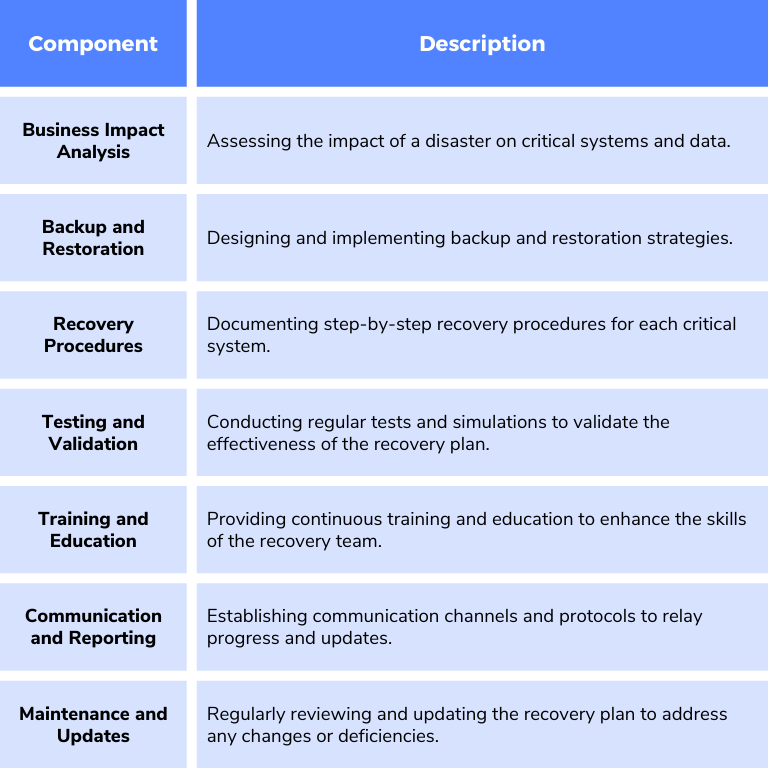When disaster strikes, whether it’s due to power outages, natural disasters, or data loss, an effective disaster recovery team plays a pivotal role in ensuring the continuity of critical business operations.
In this blog post, we will delve into the key roles, responsibilities, and best practices for building a disaster recovery team within IT departments.
Defining the roles and responsibilities
1. Team leader
At the forefront of a disaster recovery team is the team leader, who possesses the knowledge, experience, and leadership skills required to effectively manage the recovery process. The team leader should have a thorough understanding of disaster recovery planning, procedures, and technologies. They are responsible for:
– Developing and implementing disaster recovery plans, ensuring its alignment with the organization’s business objectives.
– Coordinating with key stakeholders, including executives and department heads, to establish recovery time objective (RTOs) and recovery point objective (RPOs).
– Overseeing the overall recovery process, making critical decisions during a crisis, and ensuring seamless collaboration among team members.
2. IT specialists
The disaster recovery team should include IT specialists with diverse skill sets, covering areas such as network infrastructure, systems administration, database management, and cybersecurity. Each specialist will have specific roles within the team, including:
– Assessing the impact of a disaster on critical systems and applications.
– Designing and implementing backup and restoration strategies, such as off-site data replication and redundant infrastructure.
– Conducting regular tests and simulations to validate the effectiveness of the recovery plan.
– Monitoring and managing the recovery process to ensure the restoration of normal operations within the defined RTO.
3. Communication coordinator
Effective communication is vital during a disaster recovery process to ensure seamless coordination and updates to stakeholders. The communication coordinator plays a critical role in maintaining open channels of communication. Responsibilities include:
– Establishing and maintaining primary and secondary communication channels, such as email, phone, and collaboration platforms.
– Coordinating with stakeholders, including department heads, executives, and external vendors, to relay recovery progress and updates.
– Facilitating regular team meetings and debriefings to share information, address challenges, and learn from past experiences.
Key components of an effective disaster recovery team
1. Preparing a comprehensive disaster recovery plan
A well-designed disaster recovery plan is the foundation of an effective recovery team. Key considerations in creating the plan include:
– Identifying critical systems and data: Conduct a thorough business impact analysis to identify the systems and data that are vital to the organization’s operations.
– Creating backup and restoration strategies: Develop robust backup mechanisms, considering off-site storage, redundant infrastructure, and cloud disaster recovery options.
– Documenting step-by-step disaster recovery procedures: Clearly outline the recovery process for each critical system, including the sequence of actions required to restore normal operations.

Key Components of a Disaster Recovery Plan
2. Regular testing and updating of the recovery plan
A disaster recovery plan is not a static document but an evolving one. Regular testing and updating are crucial to ensure its effectiveness. Best practices include:
– Simulating various disaster scenarios: Conduct comprehensive tests, including data recovery, system restoration, and failover procedures, to validate the recovery plan’s efficacy.
– Assessing and refining the plan: Analyze the results of the tests, identify areas for improvement, and update the plan accordingly to address any shortcomings.
3. Training and education for team members
To enhance the skills and capabilities of the disaster recovery team, continuous training and education are essential. Key practices include:
– Staying up to date with industry best practices: Encourage team members to attend relevant conferences, webinars, and training sessions to stay abreast of the latest trends and technologies in disaster recovery planning.
– Building necessary skills for recovery efforts: Provide specialized training on data recovery techniques, system restoration procedures, and emerging technologies relevant to disaster recovery.
Collaboration and communication best practices
1. Establishing clear communication channels
Effective communication is the cornerstone of successful disaster recovery efforts. It is crucial to establish clear communication channels and protocols, such as:
– Designating primary and secondary communication methods: Ensure that team members can communicate promptly and effectively, even if one communication channel fails.
– Utilizing technology for remote collaboration: Leverage collaboration platforms and tools to facilitate real-time communication, file sharing, and task management, especially during remote or distributed recovery efforts.
2. Conducting regular team meetings and debriefings
Regular team meetings and debriefings are essential for sharing information, addressing challenges, and improving future recovery responses. Best practices include:
– Sharing progress updates and challenges: Keep team members informed about recovery progress, discuss any obstacles encountered, and offer assistance or suggestions.
– Learning from past experiences: Conduct post-recovery debriefings to identify areas of improvement, discuss lessons learned, and update the recovery plan accordingly.
Business continuity planning
1. Coordinating with other departments and stakeholders
Disaster recovery efforts extend beyond the IT department. Collaborating with other departments and stakeholders is crucial to ensure business continuity. Key practices include:
– Understanding business priorities and dependencies: Engage with department heads and executives to identify critical business processes and their dependencies on IT systems.
– Collaborating for seamless recovery efforts: Establish communication channels with other departments, such as HR, finance, and customer support, to synchronize recovery efforts and minimize disruptions.
2. Engaging external resources and vendors
In some cases, external expertise and resources may be necessary to augment the capabilities of the internal disaster recovery team. Consider the following practices:
– Assessing the need for external expertise: Evaluate whether specific disaster recovery skills or technologies are best sourced externally, such as specialized recovery services or cloud-based disaster recovery sites.
– Establishing partnerships for enhanced support: Engage with third-party vendors or service providers who can offer additional support during a crisis, such as data recovery specialists or infrastructure providers.
Addressing potential challenges
1. Dealing with high-stress situations
During a disaster, the stress on the recovery team can be overwhelming. It is essential to implement stress management techniques and support team members’ mental well-being. Consider the following practices:
– Providing stress management resources: Offer stress management training, counseling services, or resources to help team members cope with high-pressure situations.
– Promoting a supportive work environment: Foster a culture of collaboration, empathy, and open communication to ensure that team members feel supported and can rely on each other during difficult times.
2. Overcoming resource limitations
Resource limitations can pose significant challenges during a recovery process. Mitigate these limitations by maximizing available resources through efficient planning and advocating for necessary investments. Consider the following practices:
– Maximizing available resources: Prioritize critical systems and data during the recovery process to allocate resources effectively.
– Advocating for necessary investments: Make a compelling case to management for the allocation of sufficient resources to strengthen disaster recovery capabilities, such as additional hardware, software, or personnel.
Conclusion
Building a disaster recovery team within your IT department is a critical step towards ensuring business continuity in the face of potential disruptions. By defining the roles and responsibilities, implementing best practices, and fostering effective collaboration and communication, your team will be well-prepared to recover swiftly and maintain normal operations when disaster strikes. Remember, a robust disaster recovery plan, regular testing, and continuous training are the pillars of a successful recovery team. Invest in these key aspects, and you will establish a resilient and reliable disaster recovery capability for your organization.






